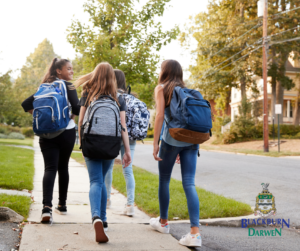Active kids do better at school, and by introducing more walking to short journeys we can reduce the amount of cars on the road at peak times, making it safer for everyone.
Congestion causes problems for local air quality, and research shows kids in our communities need to be more active to help them avoid long term health issues.
We know parents want children to get to school safely, and one of the ways to help improve safety for all school children is to switch from driving to walking, even if it’s the last few blocks.
You could introduce walking, scooting or skipping the school run by choosing to do the morning or afternoon journey at first, before suggesting both trips.
There are a number of ways we can reduce local congestion and the road safety team at BwD Council is working with a number of schools in the borough to make a safer school gate experience. If you want us to work with your school, drop us a line using the email at the end of this article.
- The school run can be your path to #betterhealth, if possible and is safe to do so, consider walking to school
- Nearly 75% of primary, and 50% of secondary school children in the UK live within 2km of their school, which is an achievable distance for both walking or cycling
- Walking the school run can help you and your family maintain a healthy weight. If there are safety reasons as to why you don’t want your children to cycle or walk to school, it would be good to understand why – you can have your say via the survey currently open to all BwD residents #activetravel
Teaching your child road safety
When introducing young children to road safety it’s important to remember that they perceive traffic in different ways to adults.
They can’t always judge the speed or distance of vehicles or where the sound is coming from because their peripheral vision is two-thirds that of an adult.
Children can also be easily distracted.
What you can do:
- Set an example: stop, look and listen, don’t take risks and avoid using your mobile phone when crossing the road
- Hold hands as you walk and cross so that they can be guided by you
- Bend down to their eye level to get an idea of what they can and can’t see
- Find a safe place to cross where you can see easily, ideally at a crossing or away from parked cars and when it’s clear, walk straight across
- Talk about the traffic you see on your way and the best places to cross, and ask questions about the speed and size of different vehicles
- In quiet areas, gradually allow your children to practice making decisions about where and when to cross the road.
As children reach age 11 they usually want to become more independent. Encourage them to make their own decisions and reinforce road safety awareness:
- Practice walking to school and to other destinations together. Start to let them lead the way and make decisions about where and when to cross
- Once you’re both confident, they could walk a little further ahead
- When they are ready to go it alone, work out a route together using quieter roads and avoiding busy junctions. Walk the route with them to point out good crossing points and things to watch out for
- Encourage them to walk with local friends (you may want to set some ground rules with other parents first)
- Remind them to avoid distractions such as chatting to friends, using mobile phones or wearing earphones when crossing roads.
For more information on a safer school run contact Karen.timperley@blackburn.gov.uk

